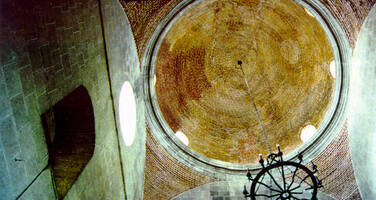Baroque Churches of the Philippines
Factors affecting the property in 2000*
- Housing
- Ritual / spiritual / religious and associative uses
- Water (rain/water table)
Factors* affecting the property identified in previous reports
- Proposed plan for building an ossuary to replace the original 159 crypt burials
- Need for long-term solution to control the flow of heavy rain water
International Assistance: requests for the property until 2000
Total amount approved : 27,000 USD
| 1998 | On-site promotion for the Baroque Churches of the ... (Approved) | 5,000 USD |
| 1997 | Training to enhance the management of the Baroque ... (Approved) | 22,000 USD |
Missions to the property until 2000**
July 1998: ICOMOS expert mission; July 2000: ICOMOS reactive monitoring mission
Conservation issues presented to the World Heritage Committee in 2000
In July 2000, the World Heritage Centre received correspondence from the owners of the San Augustin Church in Manila together with supplementary information from the Philippines National Commission for UNESCO and the Permanent Delegation of the Philippines to UNESCO concerning renewed plans to construct a new building within the existing church complex to meet the demands caused by the increased congregation, and specifically, to extend the priests’ residence. The owners of the San Augustin Church suggested in a letter addressed to the Secretariat that they might consider being delisted from the site if World Heritage status causes constraints upon the use of the site. The World Heritage Centre requested ICOMOS in September to undertake a Reactive Monitoring Mission, to examine the potential negative impact the new building could cause to the integrity and authenticity of the site.
Following receipt of an international assistance request for restoration work to be undertaken for the San Augustin Church in Paoay, an ICOMOS Reactive Monitoring Mission was organized in July 2000 at the request of the World Heritage Centre. The findings and recommendations of this ICOMOS Mission will be reported at the time of the Bureau.
Summary of the interventions
Decisions adopted by the Committee in 2000
24 COM VIII.iii.35-43
State of conservation reports of cultural properties which the Committee noted
VIII.35 Brasilia (Brazil)
Peking Man Site at Zhoukoudian (China)
The Potala Palace, Lhasa (China)
VIII.36 Islamic Cairo (Egypt)
VIII.37 Roman Monuments, Cathedral St Peter and Liebfrauen-Church in Trier (Germany)
Palaces and Parks of Potsdam and Berlin (Germany)
Classical Weimar (Germany)
Hortabagy National Park (Hungary)
VIII.38 Khajuraho Group of Monuments (India) Sun Temple of Konarak (India) Petra (Jordan) Luang Prabang (Lao People's Democratic Republic) Byblos (Lebanon) Ksar Ait Ben Haddou (Morocco) VIII.39 Island of Mozambique (Mozambique) Lumbini, the Birthplace of the Lord Buddha (Nepal) Fortifications on the Caribbean Side of Panama: Portobelo - San Lorenzo (Panama) Archaeological Site of Chavin (Peru) VIII.40 Rice Terraces of the Philippine Cordilleras (Philippines)
VIII.41 Baroque Churches of the Philippines (Philippines)
VIII.42 Cultural Landscape of Sintra (Portugal)
VIII.43 Istanbul (Turkey)
Complex of Hué Monuments (Vietnam)
The Bureau may wish to examine further information provided by the Secretariat and ICOMOS at the time of the session and take a decision thereafter.
Exports
* :
The threats indicated are listed in alphabetical order; their order does not constitute a classification according to the importance of their impact on the property.
Furthermore, they are presented irrespective of the type of threat faced by the property, i.e. with specific and proven imminent danger (“ascertained danger”) or with threats which could have deleterious effects on the property’s Outstanding Universal Value (“potential danger”).
** : All mission reports are not always available electronically.


